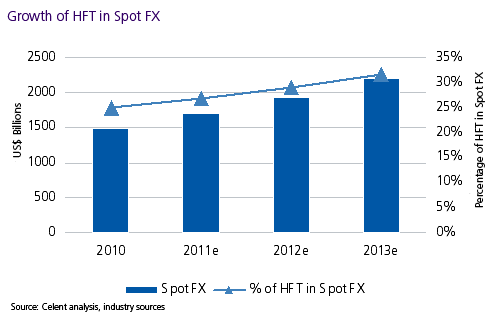Technology Choices in High Frequency FX
Infrastructure, Hardware, and Software Decisions
Abstract
HFT strategies are rapidly being adopted in the FX asset class. Celent estimates that 28% of volumes are executed through HFT, and HFT volumes are split across the interdealer and dealer-to-client segments. This is driving more firms to adopt HFT strategies, because spot is a preferred instrument of trade for the nonbank financial segment.
High frequency trading volumes in the foreign exchange asset class have been growing constantly over the past few years. This growth is primarily due to technological advances in foreign exchange trading, which have not only driven the cost of technology down but also reduced transaction costs, according to our report, Technology Choices in High Frequency FX: Infrastructure, Hardware, and Software Decisions.
In the last 10 years, FX has become a highly competitive market, and the lethargy of monopoly is gone. With the advent of multidealer platforms, banks and their dealer platforms have had to invest heavily in technology and compete on pricing. Profitability has slowly declined in other asset classes, including equities. At the same time, FX has gained recognition as a dependable asset class with enough opportunities for alpha. The existence of multiple pricing sources has attracted newer institutional and retail players, driving innovation and competition. This growth is enabled in part by the high growth of spot FX volumes.

“The software development lifecycle has to be more responsive and adaptive in FX because executing strategies need to be modified across various venues. This tilts the balance towards an in-house team for the most important components,” says Sreekrishna Sankar, Analyst with Celent’s Indian Financial Services Group and author of the report. “Providing support for fast implementation of changes in FX strategies, as well as quickly adopting efficiency opportunities and integrating the newer versions seamlessly, are key factors that differentiate one vendor from another.”
Hardware upgrades and network connectivity improvements help shave off milliseconds or nanoseconds, but these are focused on ultra-low latency strategies. In the initial phase of HFT in FX, the inefficiency of the execution venues provided opportunities for latency arbitrage. But that changed as this phase became hypercompetitive and execution venues improved. Some firms have adopted market-making strategies, and other firms have been forced to reassess their strategies.
This report debates the choices—with a fixed pool of capital, balancing investments across hardware, software, connectivity, and the network is a complex task. The report suggests practical approaches in handling the HFT requirements based on the size and the financial capabilities of the organization.

